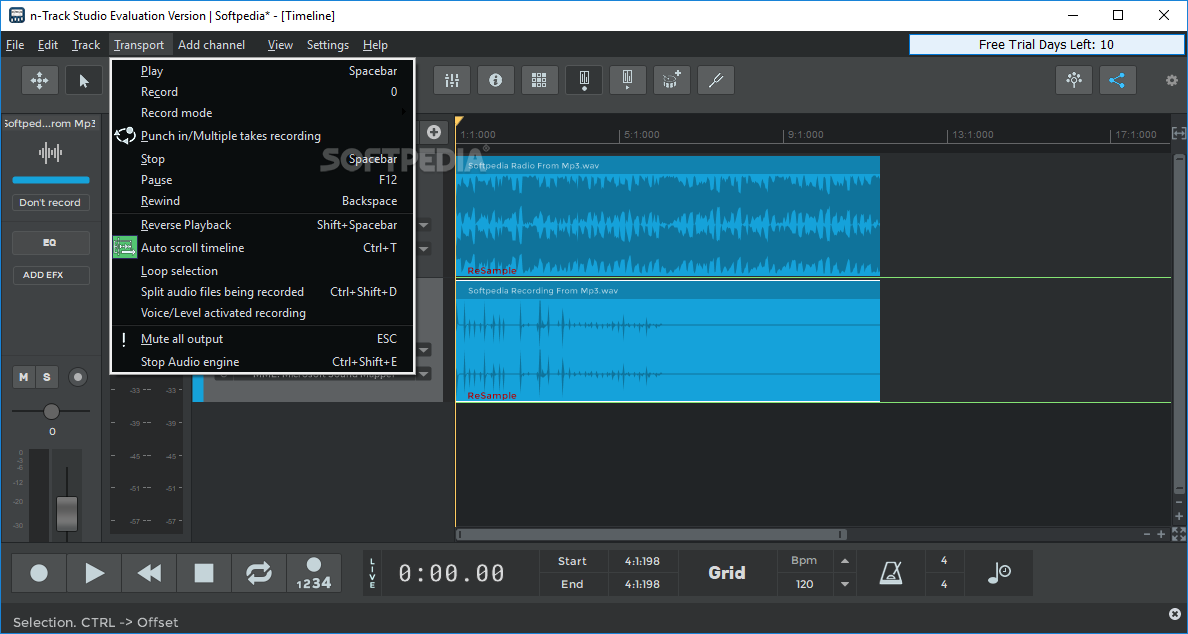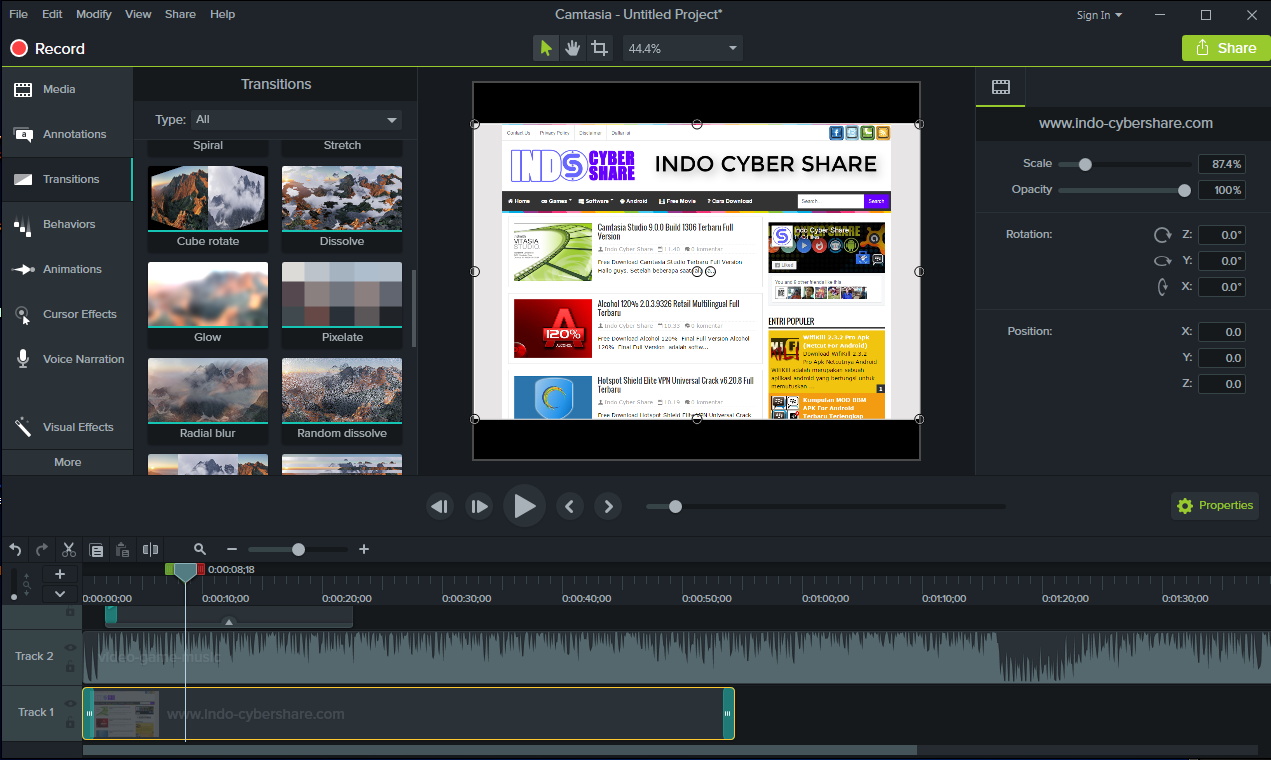“Library Content” shall mean any and all media assets embedded or displayed in the Camtasia® Library or may be accessed through TechSmith’s or its authorized licensors’ web sites, specifically, without limitation, TechSmith or other third party media assets comprised of digital still images, music, audio files. Camtasia Studio. 4 on 1104 votes. Camtasia is a desktop screen recorder and video editor. It can be useful in creating tutorials, demos, training videos, presentations, etc. This 2020 Camtasia Studio complete tutorial for beginners will teach you all the basics you need to get started with video editing. You will learn everything.
| Developer(s) | TechSmith | ||||
|---|---|---|---|---|---|
| Initial release | 28 October 2002; 18 years ago | ||||
| Stable release(s) | |||||
| |||||
| Operating system | Windows 10 1709 or later, macOS 10.14 or later[3] | ||||
| Predecessor | Camtasia 2020 | ||||
| Type | Screencasting and video editing software | ||||
| License | Proprietary | ||||
| Website | www.techsmith.com/video-editor.html | ||||
Camtasia (/kæmˈteɪʒə/; formerly Camtasia Studio) is a software suite, created and published by TechSmith, for creating video tutorials and presentations directly via screencast, or via a direct recording plug-in to Microsoft PowerPoint. Audio or other multimedia recordings may be recorded at the same time or added separately from another source.
Major components[edit]
Camtasia Studio S 10
Jul 01, 2021 Download Camtasia 21.0.5.31722 for Windows for free, without any viruses, from Uptodown. Try the latest version of Camtasia 2021 for Windows.
Camtasia consists of two major components:
- Camtasia Recorder - a separate tool for capturing screen audio and video
- Camtasia Video Editor - the component for which the entire product is named, which is now a multimedia authoring tool with a 'timeline' interface for managing multiple clips in a stacked track form.
Camtasia Recorder[edit]

Camtasia Studio Support
In Camtasia Recorder, users can start and stop recording with a hotkey combination at any time, at which point the recording can be halted and Camtasia Recorder can render the input that has been captured into a CAMREC format. The CAMREC file can be saved to disk or directly imported into the Camtasia component for editing. Camtasia Recorder allows audio recording while screen-capturing is in progress, so the presenter can capture live narration during a demonstration or presentation. Camtasia also supports dubbing in other audio tracks or voiceover during post-capture editing. Users may also download an add-in for Microsoft Power Point that will allow them to initiate recording of a presentation from within Power Point itself.
Camtasia Studio Support
Camtasia Video Editor[edit]
In Camtasia Video Editor, multimedia objects of various formats can be imported into the clip library and arrange them in time order and stacked tracks using the timeline form of user controls. Overlays of various types may be added, including user-defined settings, such as when and how to display the cursor and pan-and-zoom effects such as the Ken Burns effect.
Post-production[edit]
After capturing a presentation in the Camtasia Recorder, the Camtasia component can be used to modify audio and video displayed as tracks by using the timeline control and object library interface with an integrated preview window. The image in the infobox to the right is a screen capture of the timeline interface. In addition, Camtasia allows automatic captions (speech-to-text), voice overlay for the presenter or editor, as well as the ability to add sound effects in various formats.
Rendering and deployment[edit]
The Camtasia program allows import of various types of multimedia video and audio files including MP4, MP3, WMV, WMA, AVI, WAV and other formats into the Camtasia proprietary CAMREC format, which is readable by Camtasia. The CAMREC format is a single container for various multimedia objects including video clips, still images, document screen shots and special effect containers. The created video can be exported to common video formats including MPEG-2, MPEG-4, WMV, AVI, and Adobe Flash.
Versions[edit]
| Version | Date | Update 1 | Update 2 |
|---|---|---|---|
| 8.0.0 for Windows | 19 June 2012 | v8.6.0 of 25 August 2015 | |
| 9.0.0 | 11 October 2016 | 9.1.2 of 13 March 2018 | 9.1.5 of 7 May 2019 |
| 2018.0.0 | 19 June 2018 | 2018.0.8 of 7 May 2019 | |
| 2019.0.0 | 30 April 2019 | ||
| 2020.0.0 | 28 April 2020 | ||
| 2021.0.0 | 27 April 2021 | 2021.0.2 of 8 July 2021 for macOS[2] | 2021.0.5 of 30 June 2021 for Windows[1] |
Reviews[edit]
Camtasia's shortcomings noted in the PC World review of January 17, 2013 and CNET review of June 19, 2012 are as follows:
- Rotation of objects is applied via a dialog rather than interactively, though many lower-priced video editors do provide interactive rotation and manipulation of objects such as text and video frames
- Recording live from a DV camera is not supported
- Still potentially overwhelming for the introductory user, tempered by the tutorial material available. NOTE the V8 release is a complete rewrite so much of the prior tutorial material written for the popular Camtasia v6 and v7 software for Microsoft Windows is not usable with this release.
- Audio handling has minimal capabilities and no integration with other packages compared to some competitors in this price range
- Lacks any video-clip manipulation or integration with other packages that have such capabilities
In 2005, PC World mentioned that Camtasia is 'powerful'.[4]
In 2013, PC World published a 4 1/2 star review and noted Camtasia is a 'full-featured education/information video tool'.[5]
In 2012, CNET published a review and noted that Camtasia is a 'feature-packed screencast app' and 'does have a learning curve'.[6]
See also[edit]
References[edit]
- ^ ab'Camtasia (Windows) Version History'. TechSmith. 9 June 2021. Retrieved 25 June 2021.
- ^ ab'Camtasia (Mac) Version History'. TechSmith. 20 May 2021. Retrieved 25 June 2021.
- ^'System Requirements'. TechSmith. 3 September 2020. Archived from the original on 26 July 2017. Retrieved 3 September 2020.
- ^Bass, Steve (31 August 2005). 'Tips & Tweaks: Podcasts and Screencasts'. PC World. IDG. Retrieved 22 September 2020.
- ^Wiener Grotta, Sally; Grotta, Daniel (17 January 2013). 'Review: Camtasia Studio 8 raises the bar on interactive video creation'. PC World. IDG. Retrieved 22 September 2020.
- ^Parker, Jason (18 June 2012). 'Camtasia 8 vastly improves screencast frame rates'. CNET. CBS Interactive. Retrieved 22 September 2020.
External links[edit]
Windows
Microsoft Windows 10 (64-bit) 1709 'Creators Update' version or later. (Recommended: Microsoft Windows 10 (64-bit) 'May 2020 Update' version or later.)


6th Generation Intel® Core™ i3 Processor or 1st Generation AMD® Ryzen™ 3 Processor (Recommended: 3.5 10th Generation Intel® Core™ i5 Processor or better or 2nd Generation AMD® Ryzen™ 5 Processor or better)
- 8 GB RAM (Recommended: 16 GB or more)
- NVIDIA GeForce 10 Series or higher (Recommended)
- 4 GB of hard-disk space for program installation (Recommended: SSD with 4GB of available disk space)
- Display dimensions of 1366x768 or greater (Recommended: 1920x1080 or greater)
- Microphone: Internal microphone (Recommended: USB or other external microphone for voice recording)
- Internet connection and a TechSmith account are required for the trial and some additional connected features
- Microsoft .NET 4.7.2 or later (included), WebView2 Runtime (included), Microsoft Visual C++ 2019 Redistributable (included), Windows N requires the MediaFeature pack for Windows N.